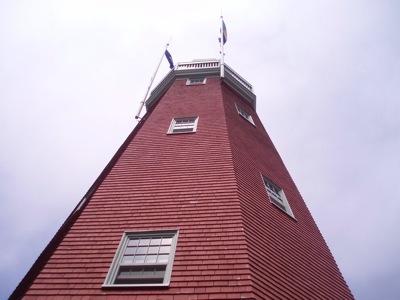Friday, July 23, 2010


By Marty Basch
In the distance, a ferry shuttles passengers to Peaks Island in Casco Bay a few miles from downtown. Below, coffee-carrying Mainers amble along the funky residential streets of Munjoy Hill in the city's East End. There is a cooling breeze atop the 86-foot high wooden tower, but clouds mask the White Mountains far in the northwest.
Had Captain Lemuel Moody been peering through his Dollond telescope back in the 1800s he would have seen steam ships, schooners, double-masted brigantines, clipper ships and other vessels loaded with cargo like coal, ice and hay entering the harbor. The former sea captain would hoist a signal flag announcing to his merchant customers their vessels were coming into the docks. That gave them a time- and money-saving heads up to secure wharf space and unload them.
Moody's lighthouse-shaped wooden tower is the country's last remaining maritime signal station. Built in 1807 , the Portland Observatory is now owned by the city and managed by the non-profit group Greater Portland Landmarks. An early Portland tourist attraction and a National Historic Landmark, the tower was instrumental in providing communication between land and ships at sea long before the explosion of cell phones and cell towers. There are seasonal guided tours and a museum.
Weather dude
Moody's observations not only made him something of a nautical town crier but also a weatherman. He recorded meteorological data three times a day and sold it to the weekly newspaper. Consider him the city's first weatherman.
The tower was only one aspect of his entrepreneurial skills. Constructed during a time when Munjoy Hill was more cow pasture than triple-deckers, the tower was on a half-acre property owned by Moody that not only had his house, but a dance hall, bowling alley, banquet hall and stables. Moody charged admission to the tower and once hosted President James Monroe in 1817 to view fireworks from the observation deck.
Though the tower's the focus, be sure to look underneath through a trap door on the ground floor. The Observatory is above ground on 122 tons of stone rubble secured by a cradle of cross beams. The tower, located next to a fire station since the 1880s, miraculously escaped fire over the years including the 1866 Great Fire of Portland but not graffiti. There's some early scrawl dating back to 1834.
Bouncing back
The Observatory was shut in 1923 after a losing battle with modern methods of communication like the telegraph and fell into disrepair until it was restored in 1939 during the Great Depression as a Work Progress Administration project. Damaging water seepage and a powder house beetle infestation forced more renovation in 1998 following a $1.28 million fund raising campaign.
A creaky circular climb to the top of the tower on the 103 steps yields a glorious panorama from city skyline to harbor lighthouses. One of the knowledgeable docents can point out the causeway leading to Mackworth Island. The island was once the summer home of Baxter State Park namesake governor Percival Baxter and now houses the Maine Educational Center for the Deaf and Hard of Hearing. Maine's tallest building, Franklin Towers, is spotted from the deck as is City Hall's dome. The walkable Old Port, Commercial Street wharves and South Portland's oil storage tanks are easily visible. So is Moody's final resting place. He died in 1846 and is buried in the Eastern Cemetery, Portland's oldest, where the view isn't as impressive.

Marty Basch photo


